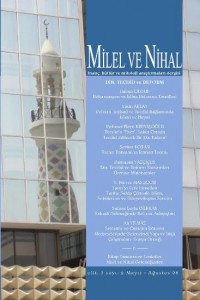Abstract
The concepts of reform, Ijtihad and tajdid, being thought in the context of their theoretical history, underlie the very characteristic of Islam as a religion of life. The gate of ijtihad in Islam is supposed to have been closed since the Ghazzali’s time. Although this idea is a widely wrong idea, it is understandable in its relevance with the post-caliphate condition where in it emerged as a defensive reaction. Nevertheless Islam as a religion of life during centuries and everywhere has always been interpreted and reinterpreted even after al-Ghazzali so that it met with numerous cultural and social experiences and produced a variety of synthesis. All these synthesis were made possible by a permanent praxis of ijtihad. In this article the hermeneutical and methodological conditions of this ijtihad will be examined and the religious relevance of the expectations for Reforming Islam will be discussed.
References
- Aktay, Yasin, 1997, Body, Text, Identity: Islamist Discourses of Authenticity in Modern Turkey, Yayınlanmamış doktora tezi, Ankara: ODTÜ.
- Aktay, Yasin, 1999, Türk Dininin Sosyolojik İmkanı: İslâm Protestanlığı ve Alevilik, İstanbul: İletişim Yayınları.
- Aktay, Yasin, 2004, Halife-Sonrası Şartlarda İslâmcılığın Öz-Diyar Algısı, Modern Türkiye’de Siyasi Düşüncü: İslâmcılık, 6. Cilt (ed. Yasin Ak- tay) İstanbul: İletişim Yayınları.
- Bourdieu, P., 1990, The Logic of Practice, translated from the French (1980) by R. Nice, California: Stanford University Press.
- Câbirî, M. A., 1997, Arap Aklının Oluşumu, Çev. İbrahim Akbaba, İstan- bul: İz.
- Clement, W. R, 2002, Reforming the Prophet: the Quest for the Islamic Reformation, Canada: Insomniac Hress.
- Feyerabend, Paul, K, 1089, Yönteme Hayır, Bir Anarşist Bilgi kuramına Dağru, Çev. Ahmet İnam, Ankara: Ara Yayınları
- Gellner, Ernest, 1981, Muslim Society, Chicago: University Press.
- Göka, Erol, Abdullah Topçuoğlu, Yasin Aktay, 1995, Önce Söz Vardı: Hermenötik Üzerine Bir Deneme, Ankara: Vadi Yayınları.
- Lapidus, Ira M. 2002, A History of Islamic Societies, 2nd edition, Cambridge: University Press (Türkçesi, Yasin Aktay, İslâm Toplumla- rı Tarihi 2 Cilt, 2002, 2009, İstanbul: İletişim Yayınları).
- Naim, Abdullah Ahmed, 1990, Toward an Islamic Reformation: Civil Liberties, Human Rights, and International Law, Syracusse: University Press.
- Roberson, B.A 2003, (ed.) Shaping the Current Islamic Reformation, London: Frank Cass Publishers.
- Subaşı, Necdet, 2003, ‚İhya‛, ‚Tecdit‛ ve ‚İslah‛ın Modern kullanımları, tezkire, sayı 33, ss. 130-153.
- Tatar, Burhanettin, 1999, Felsefi Hermenötik ve Yazarın Niyeti, Ankara: Vadi Yayınları.
- Tatar, Burhanetin, 2004, Ayrımların eşiğinde Anlama, Güncel Dini Mesele- ler Birinci İhtisas Toplantısı (Tebliğ ve Müzakereler, 02-06 Ekim 2002) Ankara: DİB Yayınevi, ss. 413-438.
- Turner, Bryan S., 1997, Max Weber ve İslâm: Eleştirel bir Yaklaşım, çev. Yasin Aktay, 2. Baskı, Ankara: Vadi Yayınları. Islam and Life
- in the Context of Reformation, Ijtihad and Tajdid
- Citation/©: Aktay, Yasin, (2008). Islam and Life in the Context of Reformation, Ijtihad and Tajdid, Milel ve Nihal, 5 (2), 43-73.
- Key Words: Islamic reformation, ijtihad, tajdid, Islamic modernization, herme- neutics of ijtihad.
Abstract
Reform, ictihad ve tecdid kavramları, teorik tarihleriyle bir arada düşünüldüğünde, İslâm’ın bir hayat dini olduğu gerçeğini belirgin bir vasfı olarak öne çıkarıyor. İslâm’da ictihad kapısının kapanmış olduğuna dair genel kabul görmüş düşünce yanlış olmakla birlikte İslâm’ın halife sonrası durumuyla ortaya çıkmış siyasal şartları bağlamında bu fikrin yaygınlaşmış olması tesadüf değildir. İctihad kapısını kapanmış saymanın bir savunma refleksi olarak anlaşılması mümkündür. Buna karşılık İslâm bir hayat dini olarak daha önceden olduğu gibi Gazzali’den sonra da dünyanın her yanında ve tarihin her döneminde sürekli yeniden yorumlanmış ve çok farklı kültürlerle ve toplumsal tecrübelerle buluşarak değişik sentezler ortaya koymuştur. Bu sentezlerin her biri kesintisiz bir ictihad pratiği sayesinde mümkün olmuştur. Bu yazıda bu İçtihadın hermenötik ve yöntemsel koşulları irdelenecek ve modern dönemde özellikle reform beklentilerinin dini münasebeti ortaya konulmaya çalışılacaktır
References
- Aktay, Yasin, 1997, Body, Text, Identity: Islamist Discourses of Authenticity in Modern Turkey, Yayınlanmamış doktora tezi, Ankara: ODTÜ.
- Aktay, Yasin, 1999, Türk Dininin Sosyolojik İmkanı: İslâm Protestanlığı ve Alevilik, İstanbul: İletişim Yayınları.
- Aktay, Yasin, 2004, Halife-Sonrası Şartlarda İslâmcılığın Öz-Diyar Algısı, Modern Türkiye’de Siyasi Düşüncü: İslâmcılık, 6. Cilt (ed. Yasin Ak- tay) İstanbul: İletişim Yayınları.
- Bourdieu, P., 1990, The Logic of Practice, translated from the French (1980) by R. Nice, California: Stanford University Press.
- Câbirî, M. A., 1997, Arap Aklının Oluşumu, Çev. İbrahim Akbaba, İstan- bul: İz.
- Clement, W. R, 2002, Reforming the Prophet: the Quest for the Islamic Reformation, Canada: Insomniac Hress.
- Feyerabend, Paul, K, 1089, Yönteme Hayır, Bir Anarşist Bilgi kuramına Dağru, Çev. Ahmet İnam, Ankara: Ara Yayınları
- Gellner, Ernest, 1981, Muslim Society, Chicago: University Press.
- Göka, Erol, Abdullah Topçuoğlu, Yasin Aktay, 1995, Önce Söz Vardı: Hermenötik Üzerine Bir Deneme, Ankara: Vadi Yayınları.
- Lapidus, Ira M. 2002, A History of Islamic Societies, 2nd edition, Cambridge: University Press (Türkçesi, Yasin Aktay, İslâm Toplumla- rı Tarihi 2 Cilt, 2002, 2009, İstanbul: İletişim Yayınları).
- Naim, Abdullah Ahmed, 1990, Toward an Islamic Reformation: Civil Liberties, Human Rights, and International Law, Syracusse: University Press.
- Roberson, B.A 2003, (ed.) Shaping the Current Islamic Reformation, London: Frank Cass Publishers.
- Subaşı, Necdet, 2003, ‚İhya‛, ‚Tecdit‛ ve ‚İslah‛ın Modern kullanımları, tezkire, sayı 33, ss. 130-153.
- Tatar, Burhanettin, 1999, Felsefi Hermenötik ve Yazarın Niyeti, Ankara: Vadi Yayınları.
- Tatar, Burhanetin, 2004, Ayrımların eşiğinde Anlama, Güncel Dini Mesele- ler Birinci İhtisas Toplantısı (Tebliğ ve Müzakereler, 02-06 Ekim 2002) Ankara: DİB Yayınevi, ss. 413-438.
- Turner, Bryan S., 1997, Max Weber ve İslâm: Eleştirel bir Yaklaşım, çev. Yasin Aktay, 2. Baskı, Ankara: Vadi Yayınları. Islam and Life
- in the Context of Reformation, Ijtihad and Tajdid
- Citation/©: Aktay, Yasin, (2008). Islam and Life in the Context of Reformation, Ijtihad and Tajdid, Milel ve Nihal, 5 (2), 43-73.
- Key Words: Islamic reformation, ijtihad, tajdid, Islamic modernization, herme- neutics of ijtihad.
Details
| Primary Language | Turkish |
|---|---|
| Journal Section | Articles |
| Authors | |
| Publication Date | August 1, 2008 |
| Submission Date | November 5, 2014 |
| Published in Issue | Year 2008 Volume: 5 Issue: 2 |

